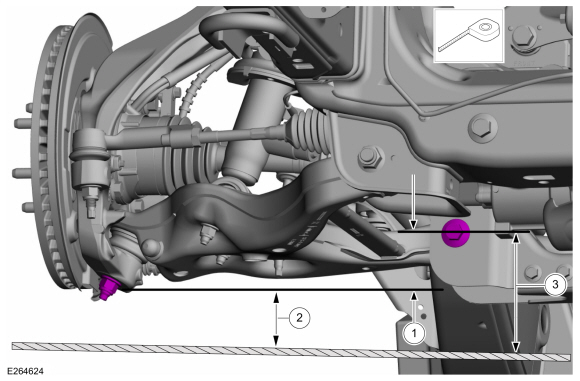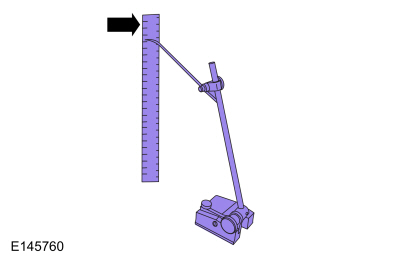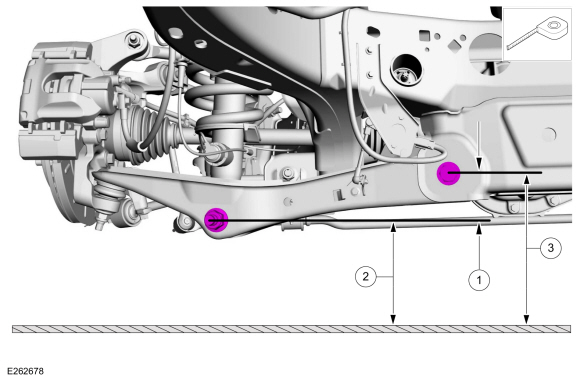Lincoln Navigator: Suspension System - General Information / Ride Height Measurement. General Procedures
Lincoln Navigator 2018-2025 Workshop Manual / Suspension / Suspension System - General Information / Ride Height Measurement. General Procedures
Special Tool(s) / General Equipment
| Surface Gauge |
Check
Ride Height Measurement — Front
-
NOTE: Make sure that the vehicle is positioned on a flat, level surface and the tires are inflated to the correct pressure. Vehicle should have a full tank of fuel.
Jounce front and rear suspension vigorously to allow the vehicle to settle.
-
Before measuring ride height check:
-
Tires are inflated to the correct pressure.
-
Vehicle should have at least one-half tank of fuel.
-
All fluids at proper levels.
-
No cargo inside the cab or bed.
-
Inspect for aftermarket equipment. Check for
aftermarket changes to the steering, suspension, wheel and tire
components (such as competition, heavy duty, etc.).
-
Tires are inflated to the correct pressure.
-
-
Ride height = 3 - 2
-
Measure the distance between the flat level
surface and the lowest point on the wheel knuckle. (measurement 2)
Use the General Equipment: Surface Gauge
-
Measure the distance between the flat level
surface and the center of the rearward lower arm bolt. (measurement 3)
Use the General Equipment: Surface Gauge
-
Ride height = 3 - 2
 |
-
With the surface gauge positioned on a flat, level
surface, record the measurement of the surface gauge position
(measurement 2) and (measurement 3).
Use the General Equipment: Surface Gauge
 |
-
Subtract measurement 2 from measurement 3 to obtain the front ride height.
Ride Height Measurement — Rear
-
NOTE: Make sure that the vehicle is positioned on a flat, level surface, transmission in the PARK position and the parking brake OFF.
Jounce front and rear suspension vigorously to allow the vehicle to settle.
-
Before measuring ride height check:
-
Tires are inflated to the correct pressure.
-
Vehicle should have at least one-half tank of fuel.
-
All fluids at proper levels.
-
No cargo inside the cab or bed.
-
Inspect for aftermarket equipment. Check for
aftermarket changes to the steering, suspension, wheel and tire
components (such as competition, heavy duty, etc.).
-
Tires are inflated to the correct pressure.
-
NOTE: Make sure that the vehicle is positioned on a flat, level surface, transmission in the PARK position and the parking brake OFF.
-
Ride height = 3 - 2
-
Measurement 3
-
Measurement 2
Use the General Equipment: Surface Gauge
-
Ride height = 3 - 2
 |
-
Measure the distance between the flat level surface
and the center of the lower arm rearward bolt (measurement 3).
-
Measure the distance between the flat level surface
and the center of the shock absorber lower bolt (rearward side)
(measurement 2).
-
Subtract measurement 2 from measurement 3 to obtain the rear ride height.
 Rear Toe Adjustment. General Procedures
Rear Toe Adjustment. General Procedures
Special Tool(s) /
General Equipment
Wheel Alignment System
Activation
NOTICE:
Do not use any tools or equipment to move the wheel and tire
assembly or suspension components while checking for relative movement...
Other information:
Lincoln Navigator 2018-2025 Workshop Manual: Engine Cooling System Draining, Vacuum Filling and Bleeding. General Procedures
Special Tool(s) / General Equipment ROB75240Coolant/Battery Refractometer (Fahrenheit) Fluid Container Cooling System Vacuum Tester and Refiller Materials Name Specification Motorcraft® Orange Prediluted Antifreeze/CoolantVC-3DIL-B WSS-M97B44-D2 Motorcraft® Yellow Concentrated Antifreeze/CoolantVC-13-G WSS-M97B57-A1 ..
Lincoln Navigator 2018-2025 Workshop Manual: Specifications
Capacities Item Types of Axle Liters Material: Motorcraft® SAE 75W-85 Premium Synthetic Hypoid Gear Lubricant / XY-75W85-QL (WSS-M2C942-A) Conventional 1.83 qt ( 1.73 L) Material: Motorcraft® Ultra Silicone Sealant / TA-29 (W..
Categories
- Manuals Home
- 4th Gen Lincoln Navigator Service Manual (2018 - 2025)
- Brake Service Mode Activation and Deactivation. General Procedures
- Transmission Fluid Drain and Refill. General Procedures
- All Terrain Control Module (ATCM). Removal and Installation
- Power Running Board (PRB). Diagnosis and Testing
- Rear Bumper. Removal and Installation
Front Driveshaft. Removal and Installation
Special Tool(s) / General Equipment
Crimping ToolMaterials
Name Specification Motorcraft® Premium Long-Life GreaseXG-1-E1 ESA-M1C75-B
Removal
With the vehicle in NEUTRAL, position the vehicle on a hoist.Refer to: Jacking and Lifting (100-02 Jacking and Lifting, Description and Operation).
Remove the bolts and the transmission shield.
Copyright © 2025 www.linavigator4.com

